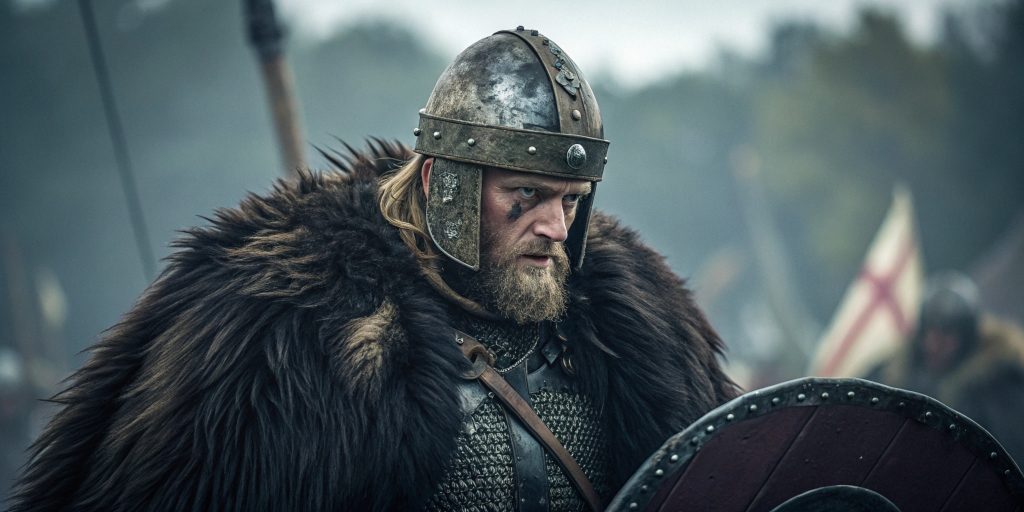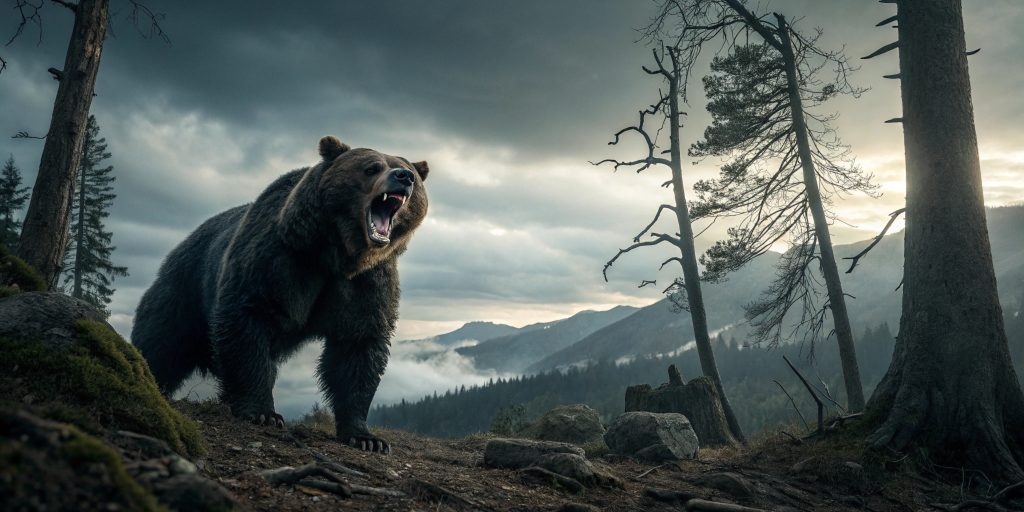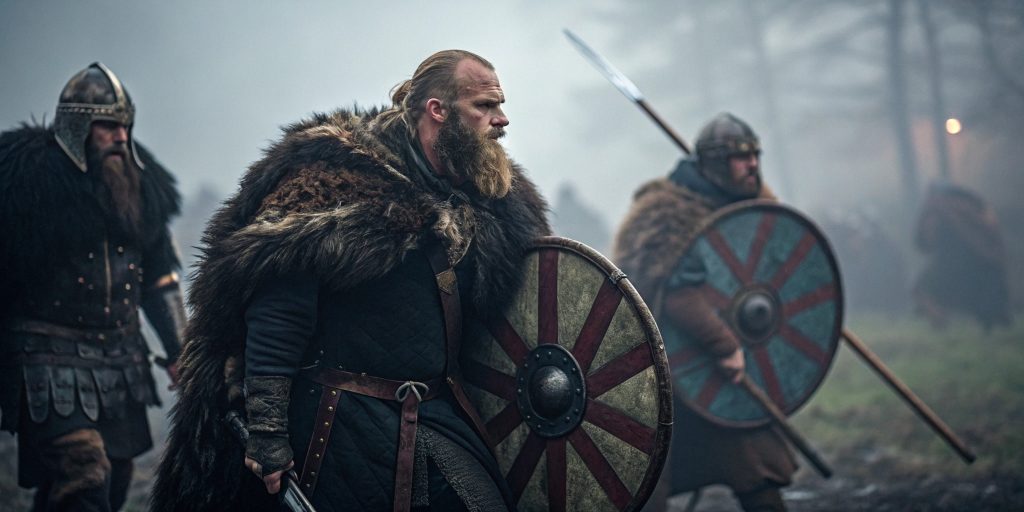Viking Clothing and Jewelry, Viking Raids and Warfare, Vikings
Did Vikings Wear Bear Pelts?
The image of a Viking bear warrior is one of fearlessness and might. They often wore bear pelts, showing their strength and ferocity. This article looks into the history of bear pelts among Norse warriors.
We will explore their cultural importance and the practices of these fierce fighters. Examining the Viking bear warriors’ attire reveals that these clothes were practical and deeply rooted in Viking culture.
Introduction to Vikings and Their Attire
The Vikings lived during the Viking Age, from the late 8th century to the early 11th century. They were known for their sailing skills and fierce raids. Their society was rich and deeply connected to their daily lives and identities.
Their warrior clothes were at the heart of their identity, which connected them to the legacy of the Viking berserkers. These clothes varied but were very practical.
Norse clothing was made of wool, perfect for Scandinavia’s cold weather. Men wore tight-fitting trousers and long tunics, and women had tight dresses at the waist. Leather boots were common, lasting long for their adventures.
Each piece of clothing showed a person’s social status and origin. This shows how vital clothes were in Viking society, particularly for the elite warriors who embodied resilience.
- Woolen tunics for warmth and versatility
- Trousers designed for comfort and mobility were essential for warriors who needed to be as strong as bears.
- Cloaks added layers for protection against weather
- Leather boots ensure ruggedness and support
Looking at their warrior clothes tells us more than just about protection. It shows their values and social structure. Their clothes helped them stand out wherever they went.
The Significance of Animal Skins in Norse Culture
Animal skins were key in Norse culture. They mixed practical uses with deep cultural beliefs. These skins gave essential materials for clothes and tools. They also carried important meanings in Norse myths.
Connection to Norse Mythology
In Norse myths, animal skins were more than clothes. They linked the physical and spiritual worlds; animals like bears were seen as symbols of strength and bravery.
The bear, linked to Odin, was thought to give warriors protection and courage. This showed the Vikings’ beliefs about the afterlife and spiritual guidance.
Practical Uses of Animal Skins
Animal skins were also practical in Viking life. They kept people warm and safe from the cold Scandinavian weather. They made durable clothes and armor.
They were also used for shields and tools needed for war. This shows the Vikings’ respect for nature and their skill in using what they had.
Exploring the Viking Bear Warrior
The Viking bear warriors were known for their strength and ferocity. They wore bear skins in battle, making them stand out. This look was not just for show; it also scared their enemies.

The Role of Bear Skins in Battle
Bear skins helped Viking warriors in many ways. They kept warm and made the warriors look bigger, embodying the fierce image of the Viking berserkers. This made enemies fear them more.
The bear skins also showed the warriors’ connection to the wild. They were seen as strong and fierce, just like bears.
Cultural Significance of the Bear Among Norse Warriors
In Norse culture, bears were symbols of power and bravery. Viking warriors wore bear skins to show their strength and courage. It was a way to honor the bear and the warrior spirit.
The Berserker Warriors of Scandinavia
Berserker warriors were known for their bravery in battle. They could enter a trance-like fury called ‘berserkergang.’ This state gave them incredible power, making them strong opponents.
They were often seen wearing animal pelts, especially bear skins. This made them look even more intimidating on the battlefield, much like the Viking berserkers known for their fierce presence.
Trance-Like Fury in Combat
In battle, berserkers tapped into a deep rage. This rage made them stronger and less sensitive to pain. They could keep fighting and take injuries that others couldn’t.
Ritual Practices of the Berserkers
Berserkers had special rituals before the battle. They would:
- Chant to summon strength and courage, a practice reminiscent of the Viking berserkers in their trance-like state before fighting.
- Drink hallucinogenic drinks, like henbane, to boost their power
- Wear animal skins to feel like a bear
These rituals showed their deep connection to Norse traditions. They believed in the power of fate and divine forces in their lives.
Evidence and Archaeological Findings
Archaeologists have found a lot of Viking stuff in Scandinavia. They’ve learned a lot about Viking life and warrior culture. They also found many Viking artifacts that show how important bear pelts were to them.
The finds show how close warriors were to the animal skins they wore. This connection is fascinating.
Artifacts Related to Bear Pelts and Warrior Culture
The Oseberg ship burial is a great example of Viking culture, and the elite warriors are honored in such ceremonies. It’s from the early 9th century. Inside were Viking artifacts like weapons and shields, reflecting the heritage of the Norse warriors who fought.
These items showed the high status of those buried. Bear pelts were also found, showing the Vikings’ respect for these animals.
These discoveries help us understand the role of bear pelts in Viking society, particularly among the berserkers who bit their shields. They were both symbolic and practical.
Literary References to Bear Warriors
Norse sagas tell exciting stories of bear warriors. These stories mix history and culture, showing how Vikings saw these fighters. Bear warriors were known for their strength and bravery.
Norse Sagas That Feature Bear Warriors
The “Saga of the Ynglings” and “Heimskringla” show bear warriors in action. These tales highlight their bravery and strength. They show how bear warriors were seen as heroes in Viking society.
Odin and the Symbolism of the Bear
The bear is important in Norse myths, especially with Odin. Odin is linked to wisdom and power, like bears and wolves. This shows the value of bear warriors in Viking stories.
Power and Strength: The Bear as a Symbol
The bear is a strong symbol in Norse culture, often associated with the resilience of Viking berserkers. It represents the traits Vikings valued: strength and bravery, which are crucial to the Viking warrior spirit.

Bear’s Characteristics and Their Meaning to Vikings
Bears are fierce and protective, traits Vikings admired. The bear symbolizes more than just physical strength. It shows a spiritual bond warriors aimed for.
- Bravery: Facing opponents with confidence and valor.
- Resilience: Withstanding hardships and remaining steadfast in battle.
- Independence: Embodying a solitary strength that resonates with the Viking strength ideal, the berserkers often howled in battle.
Vikings saw themselves in the bear’s courage and fearlessness. This bond showed their deep understanding of the warrior life.
War Arrangements: Shields and Bear Pelts
Bear pelts and Viking shields made a bold statement on the battlefield. Warriors in bear skins showed their bravery and connection to powerful animals, making them seem even more formidable as they tapped into the trance of battle.
The image of bears on shields scared enemies and showed Viking ferocity. Together, they made a strong presence that was hard to ignore.
Visual Appearance in Battle
Viking shields were often decorated, matching the raw power of bear pelts. This mix showed strength and dominance. Warriors in fur and shields looked intimidating to enemies.
The colors and designs on shields told of personal achievements and respect for bears in Old Norse culture.
Theoretical Combat Advantages
Bear pelts were thick and kept warriors warm in cold climates. They also helped absorb shock in battles, making warriors seem even more powerful.
Enemies might have been scared by warriors who seemed like bears. This mix of physical and psychological tactics gave Vikings an edge in battle.
The Transformation into “Going Berserk”
Viking warriors called berserkers wore animal pelts, like bear skins. This helped them connect with the wild nature of animals. It made them more aggressive in battle, showing a key part of Viking culture.
The Connect between Bears and the Berserk State
Wearing bear pelts was believed to give Viking berserkers the bear’s strength and ferocity. When they wore these pelts, they became wild and fierce. This wild state made them better fighters and showed them to be true warriors in their communities.
Cultural Depictions of Vikings in Modern Media
Vikings in today’s media shape how we see their culture. Movies, TV shows, and books often depict them as fierce warriors. This image of power and honor draws viewers in and changes how we think about Viking history, especially the evidence of berserkers.
How Modern Interpretations Influence Understandings
Modern Viking stories often focus on their warrior life. These tales can make Viking culture seem more exciting than it was. They show epic battles and strong leaders but might miss the society’s real depth.
When these stories don’t match history, it can cause problems. Critics say too much focus on violence and war can confuse what Viking society was really like. Important parts like trade and community life might get overlooked, but they are essential in understanding the Viking berserker culture. This shows we must be careful with what we watch and read, looking beyond the surface of Viking stories.
Viking Age Clothing and Fashion Trends
The Viking Age clothes show a mix of styles and materials, reflecting the identity of elite warriors. This mix comes from different places and social classes. Viking clothes were mainly made from wool and linen, which kept them warm in cold climates.
The colors and fabrics used varied a lot. This shows what was available and liked in different areas.
Different Styles Beyond Bear Pelts
Bear pelts were a big part of Viking clothes. But, there was more to Viking fashion. They wore:
- Tunics for both men and women are often belted at the waist.
- Pants or long skirts provided versatility and ease of movement.
- Cloaks secured with brooches that served both functional and decorative purposes.
- Embellished textiles showcasing intricate embroidery reflecting the wearer’s status and craftsmanship.
Viking clothes show the complex social life and cultural exchanges of the time. Looking at the different styles of Norse attire helps us understand the Vikings and their connection to the god Odin. It also shows their adaptability and creativity in fashion.
This understanding makes us appreciate their impact on fashion today.
Summary
The Viking bear warrior shows how culture, myths, and warrior identity meet in Norse society. These warriors were strong and spiritually connected to bears, embodying the essence of the berserker rage. This connection shaped their identity as Norse warriors who fought with the spirit of the bear.
Today, the Viking bear warrior still fascinates us, as seen in movies, books, and stories. We admire their strength, courage, and bravery, which shows how much we value them.
The Viking bear warrior is a lasting symbol of Norse culture. They show us the bravery and strength of the past. These qualities still inspire us today.

